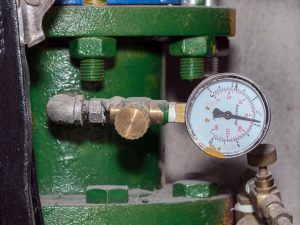 When it comes to flow-related pump problems, there are a number of potential causes: cavitation, air entrapment, suction/discharge recirculation to name a few. As reliability professionals, our customers rely on us to determine the root cause of the problem and create an actionable diagnosis.
When it comes to flow-related pump problems, there are a number of potential causes: cavitation, air entrapment, suction/discharge recirculation to name a few. As reliability professionals, our customers rely on us to determine the root cause of the problem and create an actionable diagnosis.
Gauges are one of the best yet often overlooked tools available for addressing flow-related pump issues. When properly installed, not only do gauges alert you that a serious problem is occurring, but they can also help put you on the fast-track to finding a solution.
Gauge position for accurate readings
Gauges should be mounted as close to the inlet and outlet as possible, but at least between the suction valve and pump on the suction side and between the discharge and discharge check valve on the discharge side. Mounting the discharge pressure gauge downstream of the check valve will result in a gauge that reads header pressure not necessarily pump discharge pressure. If the pump is shut down and check valve is closed, the gauge will still read whatever the header pressure is, even though the pump is not running. We’re actually seeing a lot of this occurrence on new pump installations and not sure why, as it goes against the American National Standards Institute (ANSI) specifications (ANSI K61.1).
Research pump curve
Gauges are able to give incredible insights into your pump’s operation. These tools can let you know where the problem is occurring in the pumping process, so that your customer can better direct operators where they need to look to correct it. Generally, the suction gauge indicates upstream condition, and the discharge gauge indicates downstream condition.
First, you need to establish points of reference. You can do this by researching the pump curve and becoming familiar with what is considered “too high” and “too low” for each individual model.
Once those factors are known, you can use your gauges to tell you:
- Where the pump is performing on its curve.
- If the Total Dynamic Head (TDH) is too high, the discharge gauge will read high.
- If the TDH is too low, the discharge gauge will read low.
- If the suction pressure gauge is reading low, it could be indicative of a blockage that’s preventing the system from being able to deliver enough fluid to the suction side of the pump, or the supply tank may have a low level.
- If the discharge gauge reads high, it could be an indication that the pump system can handle all the pressure. A shutoff head test will provide information to the condition of a pump’s internal tolerances and clearances.
- If both suction and discharge gauge readings are lower than normal and vibrating, air entrapment and/or vortexing could be the issue.
- If a self-priming pump requires an air release valve, the discharge gauge will show pressure before the pump is properly primed.
- If the self-priming pump can pull a proper vacuum through a maximum vacuum test.
- If a pump slowly turns backwards while it is “off”, the discharge check valve should be checked for proper seating.
Sometimes, even when it’s obvious (i.e., loud noise, lots of vibration, etc.) that there is a serious problem occurring, the gauges read completely normal. This could be an indication that the issue at hand is not related to a specific condition, but rather a problem with the pump design. In one situation that IVC was called in to evaluate, our team determined that the impeller design was not correct for the system in which it was being used. The manufacturer was then able to redesign the impeller to work with the customer’s system.
Understanding the critical information that gauges provide are key to keeping your pumps and systems working properly. At IVC, our analysts are experts in the field of condition-based monitoring and are dedicated to keeping our customers’ assets running at optimal efficiencies. Click here to see how we can do the same for you.
